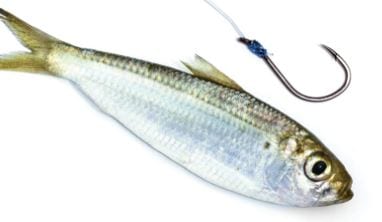
This article originally appeared on floridasportsfishing.com. It was written by Steve Dougherty.
Although there are countless artificial offerings that masterfully mimic live forage, I will tell you for certain that nothing beats the real deal. Even the most perfectly designed lures can’t duplicate the alluring vibrations and fish attracting appeal of a live baitfish. In Florida waters, offshore anglers often employ live goggle eye, blue runner, mullet, pilchard, threadfin herring, pinfish and sardines when enticing top-tier predators. While these baitfish species vary greatly in size, temperament and ruggedness in captivity, the proper hook placement is critical no matter the chosen offering.
By slightly altering the hook’s insertion point you can modify the bait’s swimming action and achieve the perfect presentation no matter the prevalent conditions or targeted species. Whether presenting live baits by way of flat lines, kites, weights or downriggers, there are a few ways you can adjust hook placement to achieve the desired reaction from your chosen offering.
Hooking live baitfish through the small area of soft tissue in the nostril is the most common and versatile presentation, but there are some advantages and disadvantages to this approach. First and foremost, the nostril of most baitfish is one of the strongest points of insertion and enables anglers to cast baits great distances without much risk of the hook ripping from the bait. Hooking live bait in the nose also enables anglers to retrieve baits with a natural swimming motion in hopes of enticing a strike on the retrieve. If your goal is to add an egg sinker in an effort to achieve a deeper presentation, you’ll want to insert the hook in the nose. As you free spool and slowly let the lead slip to the desired depth the baitfish will be pulled head first, which will keep it lively and appealing. If your hook has an offset, make sure the hook point angles downward once it is inserted in the nose. If you fail to neglect this critical aspect, the hook point could double back and impale the bait.
Although nose hooking is ideal for casting, bottom fishing, slow trolling and drifting flat lines, live baits hooked in the nose have a tendency to swim back to the boat because that is the direction the unfamiliar tether is pulling them. In addition, with a hook placed so far forward there is a lot of room for short strikes.
Moving away from the bait’s nose, shoulder hooking results in an ideal presentation for baits destined to be dangled on the surface. When pulled skyward from a kite, baitfish tend to dig and swim away from the surface. This is why kite fishing is so attractive, and there’s not much better than a live bait pulsating on the surface with little to no terminal tackle in view. If you hook a kite bait anywhere but the shoulder, it will make it difficult for the bait to swim with a natural presentation.
In scenarios where game fish are blowing up behind the boat and you know a strike is imminent you can pitch live bait with a hook more centered in the bait, which can help in eliminating short strikes. You need to be careful when impaling a hook in this region because if you sever the bait’s spinal cord you could mortally wound your previously live offering.
While you won’t get a live bait to swim to the bottom in 100 feet of water, placing your hook near the tail just behind the anal fin will force your bait to swim away from the surface. This area of the bait is generally pretty tough and you can expect a solid hold where the hook won’t pull out prematurely. When free lining a bait that’s hooked near the tail you can be sure it will swim down and away from the boat. Just know that even a slow retrieve pulling the bait backwards will be detrimental. I prefer hooking baits in this fashion when targeting flag yellowtail with juvenile pilchard.
As you can see, with only slight variation in hook placement you can effectively alter the way your live bait reacts to its unfamiliar restraint. While the photos within this column depict rigging scenarios with live pilchard, don’t hesitate to use the aforementioned techniques with scad, sardine, mullet, herring, ballyhoo or pinfish.
Finally, be extremely careful when handling live baitfish and know where you intend on piercing the hook prior to grabbing a squirming baitfish with your wet hands. It’s also important to remember that baitfish and game fish react differently to various hook placements depending on the prevalent conditions. Furthermore, preferred presentation may vary from day to day so don’t hesitate to mix things up in an effort to achieve the desired results. Good luck and handle with care.
Book A Naples Fishing Charter
Chasin’ Tales’ Naples fishing charters gives you the opportunity to make a catch in the Gulf waters. Captain Geoff has been navigating the Gulf for years! To book a trip, call 239-216-0378 or click herefor more information.
